Semiconductor devices such as diode, MOS and bipolar transistor
This package contains semiconductor devices:
Most of the semiconductor devices contain a conditional heat port, which is not active by default. If it is active the loss power is calculated to be used in a thermal net. The heating variants of the semiconductor devices are provided to use the thermal port temperature in the electric calculation. That means that for a true thermal electric interaction the heating device models have to be used.
Extends from Modelica.Icons.Package (Icon for standard packages).
| Name | Description |
|---|---|
Diode | Simple diode |
Diode2 | Improved diode model |
exlin | Exponential function linearly continued for x > Maxexp |
exlin2 | Exponential function linearly continued for x < MinExp and x > Maxexp |
HeatingDiode | Simple diode with heating port |
HeatingNMOS | Simple MOS Transistor with heating port |
HeatingNPN | Simple NPN BJT according to Ebers-Moll with heating port |
HeatingPMOS | Simple PMOS Transistor with heating port |
HeatingPNP | Simple PNP BJT according to Ebers-Moll with heating port |
NMOS | Simple MOS Transistor |
NPN | Simple BJT according to Ebers-Moll |
PMOS | Simple MOS Transistor |
PNP | Simple BJT according to Ebers-Moll |
pow | Just a helper function for x^y in order that a symbolic engine can apply some transformations more easily |
powlin | Power function (1 - x)^(-y) linearly continued for x > 0 (provided y = const.) |
SimpleTriac | Simple triac, based on Semiconductors.Thyristor model |
Thyristor | Simple Thyristor Model |
ZDiode | Zener diode with 3 working areas |
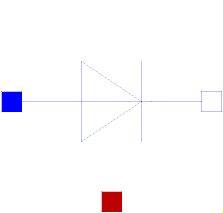 Model Modelica.Electrical.Analog.Semiconductors.Diode
Model Modelica.Electrical.Analog.Semiconductors.Diode
The simple diode is a one port. It consists of the diode itself and an parallel ohmic resistance R. The diode formula is:
v/vt i = ids ( e - 1).
If the exponent v/vt reaches the limit maxex, the diode characteristic is linearly continued to avoid overflow.
Please note: In case of useHeatPort=true the temperature dependence of the electrical behavior is not modelled yet. The parameters are not temperature dependent.
Extends from Modelica.Electrical.Analog.Interfaces.OnePort (Component with two electrical pins p and n and current i from p to n) and Modelica.Electrical.Analog.Interfaces.ConditionalHeatPort (Partial model to include a conditional HeatPort in order to describe the power loss via a thermal network).
| Type | Name | Default | Description |
|---|---|---|---|
Current | Ids | 1e-6 | Saturation current |
Voltage | Vt | 0.04 | Voltage equivalent of temperature (kT/qn) |
Real | Maxexp | 15 | Max. exponent for linear continuation |
Resistance | R | 1e+8 | Parallel ohmic resistance |
Boolean | useHeatPort | false | =true, if heatPort is enabled |
Temperature | T | 293.15 | Fixed device temperature if useHeatPort = false |
| Type | Name | Description |
|---|---|---|
PositivePin | p | Positive electrical pin |
NegativePin | n | Negative electrical pin |
HeatPort_a | heatPort | Conditional heat port |
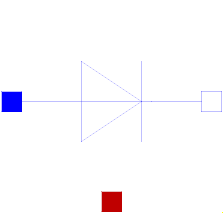 Model Modelica.Electrical.Analog.Semiconductors.Diode2
Model Modelica.Electrical.Analog.Semiconductors.Diode2
This diode model is an improved version of the simple diode model. It includes a series resistance, parallel conductance, and also models reverse breakdown. The model is divided into three parts:
Temperature dependent behaviour is modelled when useHeatPort=true. In that case, the Vt parameter is ignored, and Vt is computed as k·T/q, where
Extends from Modelica.Electrical.Analog.Interfaces.OnePort (Component with two electrical pins p and n and current i from p to n) and Modelica.Electrical.Analog.Interfaces.ConditionalHeatPort (Partial model to include a conditional HeatPort in order to describe the power loss via a thermal network).
| Type | Name | Default | Description |
|---|---|---|---|
Boolean | useHeatPort | false | =true, if heatPort is enabled |
Temperature | T | 293.15 | Fixed device temperature if useHeatPort = false |
Voltage | Vf | 0.7 | Forward voltage |
Current | Ids | 1e-13 | Reverse saturation current |
Resistance | Rs | 16 | Ohmic resistance |
Voltage | Vt | Modelica.Constants.R * T / Modelica.Constants.F | Thermal voltage (kT/q), 0.026 at normal conditions (around 20 degC) |
Real | N | 1 | Emission coefficient |
Voltage | Bv | 100 | Reverse breakdown voltage |
Conductance | Gp | 1e-6 | Parallel conductance for numerical stability |
| Type | Name | Description |
|---|---|---|
PositivePin | p | Positive electrical pin |
NegativePin | n | Negative electrical pin |
HeatPort_a | heatPort | Conditional heat port |
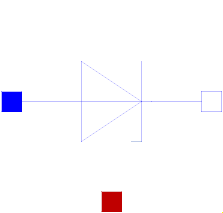 Model Modelica.Electrical.Analog.Semiconductors.ZDiode
Model Modelica.Electrical.Analog.Semiconductors.ZDiode
The simple Zener diode is a one port. It consists of the diode itself and an parallel ohmic resistance R. The diode formula is:
v/Vt -(v+Bv)/(Nbv*Vt) i = Ids ( e - 1) - Ibv ( e ).
If the exponent in one of the two branches reaches the limit Maxexp, the diode characteristic is linearly continued to avoid overflow.
The Zener diode model permits (in contrast to the simple diode model) current in reverse direction if the breakdown voltage Bv (also known Zener knee voltage) is exceeded.
The thermal power is calculated by i*v.
Please note: In case of useHeatPort=true the temperature dependence of the electrical behavior is not modelled yet. The parameters are not temperature dependent.
Extends from Modelica.Electrical.Analog.Interfaces.OnePort (Component with two electrical pins p and n and current i from p to n) and Modelica.Electrical.Analog.Interfaces.ConditionalHeatPort (Partial model to include a conditional HeatPort in order to describe the power loss via a thermal network).
| Type | Name | Default | Description |
|---|---|---|---|
Current | Ids | 1e-6 | Saturation current |
Voltage | Vt | 0.04 | Voltage equivalent of temperature (kT/qn) |
Real | Maxexp | 30 | Max. exponent for linear continuation |
Resistance | R | 1e+8 | Parallel ohmic resistance |
Voltage | Bv | 5.1 | Breakthrough voltage = Zener- or Z-voltage |
Current | Ibv | 0.7 | Breakthrough knee current |
Real | Nbv | 0.74 | Breakthrough emission coefficient |
Boolean | useHeatPort | false | =true, if heatPort is enabled |
Temperature | T | 293.15 | Fixed device temperature if useHeatPort = false |
| Type | Name | Description |
|---|---|---|
PositivePin | p | Positive electrical pin |
NegativePin | n | Negative electrical pin |
HeatPort_a | heatPort | Conditional heat port |
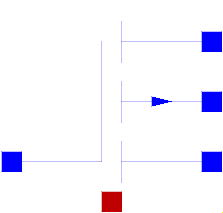 Model Modelica.Electrical.Analog.Semiconductors.PMOS
Model Modelica.Electrical.Analog.Semiconductors.PMOS
The PMOS model is a simple model of a p-channel metal-oxide semiconductor FET. It differs slightly from the device used in the SPICE simulator. For more details please care for H. Spiro.
The model does not consider capacitances. A high drain-source resistance RDS
is included to avoid numerical difficulties.
Please note:
In case of useHeatPort=true the temperature dependence of the electrical
behavior is not modelled yet. The parameters are not temperature dependent.
Some typical parameter sets are:
W L Beta Vt K2 K5 DW DL m m A/V^2 V - - m m 50.e-6 8.e-6 0.0085e-3 -0.15 0.41 0.839 -3.8e-6 -4.0e-6 20.e-6 6.e-6 0.0105e-3 -1.0 0.41 0.839 -2.5e-6 -2.1e-6 30.e-6 5.e-6 0.0059e-3 -0.3 0.98 1.01 0 -3.9e-6 30.e-6 5.e-6 0.0152e-3 -0.69 0.104 1.1 -0.8e-6 -0.4e-6 30.e-6 5.e-6 0.0163e-3 -0.69 0.104 1.1 -0.8e-6 -0.4e-6 30.e-6 5.e-6 0.0182e-3 -0.69 0.086 1.06 -0.1e-6 -0.6e-6 20.e-6 6.e-6 0.0074e-3 -1. 0.4 0.59 0 0
Extends from Modelica.Electrical.Analog.Interfaces.ConditionalHeatPort (Partial model to include a conditional HeatPort in order to describe the power loss via a thermal network).
| Type | Name | Default | Description |
|---|---|---|---|
Length | W | 2e-5 | Width |
Length | L | 6e-6 | Length |
Transconductance | Beta | 1.05e-5 | Transconductance parameter |
Voltage | Vt | -1 | Zero bias threshold voltage |
Real | K2 | 0.41 | Bulk threshold parameter |
Real | K5 | 0.839 | Reduction of pinch-off region |
Length | dW | -2.5e-6 | Narrowing of channel |
Length | dL | -2.1e-6 | Shortening of channel |
Resistance | RDS | 1e+7 | Drain-Source-Resistance |
Boolean | useHeatPort | false | =true, if heatPort is enabled |
Temperature | T | 293.15 | Fixed device temperature if useHeatPort = false |
| Type | Name | Description |
|---|---|---|
Pin | D | Drain |
Pin | G | Gate |
Pin | S | Source |
Pin | B | Bulk |
HeatPort_a | heatPort | Conditional heat port |
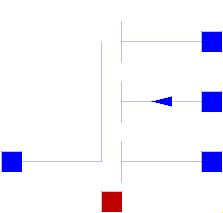 Model Modelica.Electrical.Analog.Semiconductors.NMOS
Model Modelica.Electrical.Analog.Semiconductors.NMOS
The NMOS model is a simple model of a n-channel metal-oxide semiconductor FET. It differs slightly from the device used in the SPICE simulator. For more details please care for H. Spiro.
The model does not consider capacitances. A high drain-source resistance RDS
is included to avoid numerical difficulties.
Please note:
In case of useHeatPort=true the temperature dependence of the electrical
behavior is not modelled yet. The parameters are not temperature dependent.
W L Beta Vt K2 K5 DW DL m m A/V^2 V - - m m 12.e-6 4.e-6 0.062e-3 -4.5 0.24 0.61 -1.2e-6 -0.9e-6 depletion 60.e-6 3.e-6 0.048e-3 0.1 0.08 0.68 -1.2e-6 -0.9e-6 enhancement 12.e-6 4.e-6 0.0625e-3 -0.8 0.21 0.78 -1.2e-6 -0.9e-6 zero 50.e-6 8.e-6 0.0299e-3 0.24 1.144 0.7311 -5.4e-6 -4.e-6 20.e-6 6.e-6 0.041e-3 0.8 1.144 0.7311 -2.5e-6 -1.5e-6 30.e-6 9.e-6 0.025e-3 -4.0 0.861 0.878 -3.4e-6 -1.74e-6 30.e-6 5.e-6 0.031e-3 0.6 1.5 0.72 0 -3.9e-6 50.e-6 6.e-6 0.0414e-3 -3.8 0.34 0.8 -1.6e-6 -2.e-6 depletion 50.e-6 5.e-6 0.03e-3 0.37 0.23 0.86 -1.6e-6 -2.e-6 enhancement 50.e-6 6.e-6 0.038e-3 -0.9 0.23 0.707 -1.6e-6 -2.e-6 zero 20.e-6 4.e-6 0.06776e-3 0.5409 0.065 0.71 -0.8e-6 -0.2e-6 20.e-6 4.e-6 0.06505e-3 0.6209 0.065 0.71 -0.8e-6 -0.2e-6 20.e-6 4.e-6 0.05365e-3 0.6909 0.03 0.8 -0.3e-6 -0.2e-6 20.e-6 4.e-6 0.05365e-3 0.4909 0.03 0.8 -0.3e-6 -0.2e-6 12.e-6 4.e-6 0.023e-3 -4.5 0.29 0.6 0 0 depletion 60.e-6 3.e-6 0.022e-3 0.1 0.11 0.65 0 0 enhancement 12.e-6 4.e-6 0.038e-3 -0.8 0.33 0.6 0 0 zero 20.e-6 6.e-6 0.022e-3 0.8 1 0.66 0 0
Extends from Modelica.Electrical.Analog.Interfaces.ConditionalHeatPort (Partial model to include a conditional HeatPort in order to describe the power loss via a thermal network).
| Type | Name | Default | Description |
|---|---|---|---|
Length | W | 2e-5 | Width |
Length | L | 6e-6 | Length |
Transconductance | Beta | 4.1e-5 | Transconductance parameter |
Voltage | Vt | 0.8 | Zero bias threshold voltage |
Real | K2 | 1.144 | Bulk threshold parameter |
Real | K5 | 0.7311 | Reduction of pinch-off region |
Length | dW | -2.5e-6 | Narrowing of channel |
Length | dL | -1.5e-6 | Shortening of channel |
Resistance | RDS | 1e+7 | Drain-Source-Resistance |
Boolean | useHeatPort | false | =true, if heatPort is enabled |
Temperature | T | 293.15 | Fixed device temperature if useHeatPort = false |
| Type | Name | Description |
|---|---|---|
Pin | D | Drain |
Pin | G | Gate |
Pin | S | Source |
Pin | B | Bulk |
HeatPort_a | heatPort | Conditional heat port |
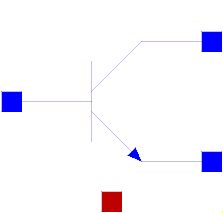 Model Modelica.Electrical.Analog.Semiconductors.NPN
Model Modelica.Electrical.Analog.Semiconductors.NPN
This model is a simple model of a bipolar NPN junction transistor according
to Ebers-Moll.
Please note:
In case of useHeatPort=true the temperature dependence of the electrical
behavior is not modelled yet. The parameters are not temperature dependent.
A typical parameter set is:
Bf Br Is Vak Tauf Taur Ccs Cje Cjc Phie Me PHic Mc Gbc Gbe Vt - - A V s s F F F V - V - mS mS V 50 0.1 1e-16 0.02 0.12e-9 5e-9 1e-12 0.4e-12 0.5e-12 0.8 0.4 0.8 0.333 1e-15 1e-15 0.02585
Extends from Modelica.Electrical.Analog.Interfaces.ConditionalHeatPort (Partial model to include a conditional HeatPort in order to describe the power loss via a thermal network).
| Type | Name | Default | Description |
|---|---|---|---|
Real | Bf | 50 | Forward beta |
Real | Br | 0.1 | Reverse beta |
Current | Is | 1e-16 | Transport saturation current |
InversePotential | Vak | 0.02 | Early voltage (inverse), 1/Volt |
Time | Tauf | 1.2e-10 | Ideal forward transit time |
Time | Taur | 5e-9 | Ideal reverse transit time |
Capacitance | Ccs | 1e-12 | Collector-substrate(ground) cap. |
Capacitance | Cje | 4e-13 | Base-emitter zero bias depletion cap. |
Capacitance | Cjc | 5e-13 | Base-coll. zero bias depletion cap. |
Voltage | Phie | 0.8 | Base-emitter diffusion voltage |
Real | Me | 0.4 | Base-emitter gradation exponent |
Voltage | Phic | 0.8 | Base-collector diffusion voltage |
Real | Mc | 0.333 | Base-collector gradation exponent |
Conductance | Gbc | 1e-15 | Base-collector conductance |
Conductance | Gbe | 1e-15 | Base-emitter conductance |
Voltage | Vt | 0.02585 | Voltage equivalent of temperature |
Real | EMin | -100 | if x < EMin, the exp(x) function is linearized |
Real | EMax | 40 | if x > EMax, the exp(x) function is linearized |
Voltage | IC | 0 | Initial value |
Boolean | UIC | false | Decision if initial value should be used |
Boolean | useHeatPort | false | =true, if heatPort is enabled |
Temperature | T | 293.15 | Fixed device temperature if useHeatPort = false |
| Type | Name | Description |
|---|---|---|
HeatPort_a | heatPort | Conditional heat port |
Pin | C | Collector |
Pin | B | Base |
Pin | E | Emitter |
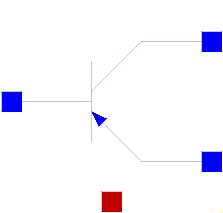 Model Modelica.Electrical.Analog.Semiconductors.PNP
Model Modelica.Electrical.Analog.Semiconductors.PNP
This model is a simple model of a bipolar PNP junction transistor according
to Ebers-Moll.
Please note:
In case of useHeatPort=true the temperature dependency of the electrical
behavior is not modelled yet. The parameters are not temperature dependent.
A typical parameter set is:
Bf Br Is Vak Tauf Taur Ccs Cje Cjc Phie Me PHic Mc Gbc Gbe Vt - - A V s s F F F V - V - mS mS V 50 0.1 1e-16 0.02 0.12e-9 5e-9 1e-12 0.4e-12 0.5e-12 0.8 0.4 0.8 0.333 1e-15 1e-15 0.02585
Extends from Modelica.Electrical.Analog.Interfaces.ConditionalHeatPort (Partial model to include a conditional HeatPort in order to describe the power loss via a thermal network).
| Type | Name | Default | Description |
|---|---|---|---|
Real | Bf | 50 | Forward beta |
Real | Br | 0.1 | Reverse beta |
Current | Is | 1e-16 | Transport saturation current |
InversePotential | Vak | 0.02 | Early voltage (inverse), 1/Volt |
Time | Tauf | 1.2e-10 | Ideal forward transit time |
Time | Taur | 5e-9 | Ideal reverse transit time |
Capacitance | Ccs | 1e-12 | Collector-substrate(ground) cap. |
Capacitance | Cje | 4e-13 | Base-emitter zero bias depletion cap. |
Capacitance | Cjc | 5e-13 | Base-coll. zero bias depletion cap. |
Voltage | Phie | 0.8 | Base-emitter diffusion voltage |
Real | Me | 0.4 | Base-emitter gradation exponent |
Voltage | Phic | 0.8 | Base-collector diffusion voltage |
Real | Mc | 0.333 | Base-collector gradation exponent |
Conductance | Gbc | 1e-15 | Base-collector conductance |
Conductance | Gbe | 1e-15 | Base-emitter conductance |
Voltage | Vt | 0.02585 | Voltage equivalent of temperature |
Real | EMin | -100 | if x < EMin, the exp(x) function is linearized |
Real | EMax | 40 | if x > EMax, the exp(x) function is linearized |
Boolean | useHeatPort | false | =true, if heatPort is enabled |
Temperature | T | 293.15 | Fixed device temperature if useHeatPort = false |
| Type | Name | Description |
|---|---|---|
HeatPort_a | heatPort | Conditional heat port |
Pin | C | Collector |
Pin | B | Base |
Pin | E | Emitter |
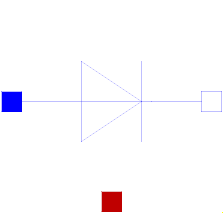 Model Modelica.Electrical.Analog.Semiconductors.HeatingDiode
Model Modelica.Electrical.Analog.Semiconductors.HeatingDiode
The simple diode is an electrical one port, where a heat port is added, which is defined in the Modelica.Thermal library. It consists of the diode itself and an parallel ohmic resistance R. The diode formula is:
v/vt_t
i = ids ( e - 1).
where vt_t depends on the temperature of the heat port:
vt_t = k*temp/q
If the exponent v/vt_t reaches the limit maxex, the diode characteristic is linearly
continued to avoid overflow.
The thermal power is calculated by i*v.
Extends from Modelica.Electrical.Analog.Interfaces.OnePort (Component with two electrical pins p and n and current i from p to n) and Modelica.Electrical.Analog.Interfaces.ConditionalHeatPort (Partial model to include a conditional HeatPort in order to describe the power loss via a thermal network).
| Type | Name | Default | Description |
|---|---|---|---|
Current | Ids | 1e-6 | Saturation current |
Real | Maxexp | 15 | Max. exponent for linear continuation |
Resistance | R | 1e+8 | Parallel ohmic resistance |
Real | EG | 1.11 | Activation energy |
Real | N | 1 | Emission coefficient |
Temperature | TNOM | 300.15 | Parameter measurement temperature |
Real | XTI | 3 | Temperature exponent of saturation current |
Boolean | useHeatPort | true | =true, if heatPort is enabled |
Temperature | T | 293.15 | Fixed device temperature if useHeatPort = false |
| Type | Name | Description |
|---|---|---|
PositivePin | p | Positive electrical pin |
NegativePin | n | Negative electrical pin |
HeatPort_a | heatPort | Conditional heat port |
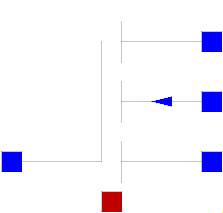 Model Modelica.Electrical.Analog.Semiconductors.HeatingNMOS
Model Modelica.Electrical.Analog.Semiconductors.HeatingNMOS
The NMOS model is a simple model of a n-channel metal-oxide semiconductor FET. It differs slightly from the device used in the SPICE simulator. For more details please care for H. Spiro.
A heating port is added for thermal electric simulation. The heating port is defined in the Modelica.Thermal library.
The model does not consider capacitances. A high drain-source resistance RDS is included to avoid numerical difficulties.
W L Beta Vt K2 K5 DW DL m m A/V^2 V - - m m 12.e-6 4.e-6 0.062e-3 -4.5 0.24 0.61 -1.2e-6 -0.9e-6 depletion 60.e-6 3.e-6 0.048e-3 0.1 0.08 0.68 -1.2e-6 -0.9e-6 enhancement 12.e-6 4.e-6 0.0625e-3 -0.8 0.21 0.78 -1.2e-6 -0.9e-6 zero 50.e-6 8.e-6 0.0299e-3 0.24 1.144 0.7311 -5.4e-6 -4.e-6 20.e-6 6.e-6 0.041e-3 0.8 1.144 0.7311 -2.5e-6 -1.5e-6 30.e-6 9.e-6 0.025e-3 -4.0 0.861 0.878 -3.4e-6 -1.74e-6 30.e-6 5.e-6 0.031e-3 0.6 1.5 0.72 0 -3.9e-6 50.e-6 6.e-6 0.0414e-3 -3.8 0.34 0.8 -1.6e-6 -2.e-6 depletion 50.e-6 5.e-6 0.03e-3 0.37 0.23 0.86 -1.6e-6 -2.e-6 enhancement 50.e-6 6.e-6 0.038e-3 -0.9 0.23 0.707 -1.6e-6 -2.e-6 zero 20.e-6 4.e-6 0.06776e-3 0.5409 0.065 0.71 -0.8e-6 -0.2e-6 20.e-6 4.e-6 0.06505e-3 0.6209 0.065 0.71 -0.8e-6 -0.2e-6 20.e-6 4.e-6 0.05365e-3 0.6909 0.03 0.8 -0.3e-6 -0.2e-6 20.e-6 4.e-6 0.05365e-3 0.4909 0.03 0.8 -0.3e-6 -0.2e-6 12.e-6 4.e-6 0.023e-3 -4.5 0.29 0.6 0 0 depletion 60.e-6 3.e-6 0.022e-3 0.1 0.11 0.65 0 0 enhancement 12.e-6 4.e-6 0.038e-3 -0.8 0.33 0.6 0 0 zero 20.e-6 6.e-6 0.022e-3 0.8 1 0.66 0 0
References:
Spiro, H.: Simulation integrierter Schaltungen. R. Oldenbourg Verlag Muenchen Wien 1990.
Extends from Modelica.Electrical.Analog.Interfaces.ConditionalHeatPort (Partial model to include a conditional HeatPort in order to describe the power loss via a thermal network).
| Type | Name | Default | Description |
|---|---|---|---|
Length | W | 2e-5 | Width |
Length | L | 6e-6 | Length |
Transconductance | Beta | 4.1e-5 | Transconductance parameter |
Voltage | Vt | 0.8 | Zero bias threshold voltage |
Real | K2 | 1.144 | Bulk threshold parameter |
Real | K5 | 0.7311 | Reduction of pinch-off region |
Length | dW | -2.5e-6 | Narrowing of channel |
Length | dL | -1.5e-6 | Shortening of channel |
Resistance | RDS | 1e+7 | Drain-Source-Resistance |
Temperature | Tnom | 300.15 | Parameter measurement temperature |
Real | kvt | -0.00696 | Fitting parameter for Vt |
Real | kk2 | 6e-4 | Fitting parameter for K2 |
Boolean | useHeatPort | true | =true, if heatPort is enabled |
Temperature | T | 293.15 | Fixed device temperature if useHeatPort = false |
| Type | Name | Description |
|---|---|---|
Pin | D | Drain |
Pin | G | Gate |
Pin | S | Source |
Pin | B | Bulk |
HeatPort_a | heatPort | Conditional heat port |
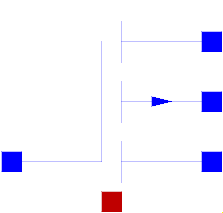 Model Modelica.Electrical.Analog.Semiconductors.HeatingPMOS
Model Modelica.Electrical.Analog.Semiconductors.HeatingPMOS
The PMOS model is a simple model of a p-channel metal-oxide semiconductor FET. It differs slightly from the device used in the SPICE simulator. For more details please care for H. Spiro.
A heating port is added for thermal electric simulation. The heating port is defined in the Modelica.Thermal library.
The model does not consider capacitances. A high drain-source resistance RDS is included to avoid numerical difficulties.
Some typical parameter sets are:
W L Beta Vt K2 K5 DW DL m m A/V^2 V - - m m 50.e-6 8.e-6 0.0085e-3 -0.15 0.41 0.839 -3.8e-6 -4.0e-6 20.e-6 6.e-6 0.0105e-3 -1.0 0.41 0.839 -2.5e-6 -2.1e-6 30.e-6 5.e-6 0.0059e-3 -0.3 0.98 1.01 0 -3.9e-6 30.e-6 5.e-6 0.0152e-3 -0.69 0.104 1.1 -0.8e-6 -0.4e-6 30.e-6 5.e-6 0.0163e-3 -0.69 0.104 1.1 -0.8e-6 -0.4e-6 30.e-6 5.e-6 0.0182e-3 -0.69 0.086 1.06 -0.1e-6 -0.6e-6 20.e-6 6.e-6 0.0074e-3 -1. 0.4 0.59 0 0
Extends from Modelica.Electrical.Analog.Interfaces.ConditionalHeatPort (Partial model to include a conditional HeatPort in order to describe the power loss via a thermal network).
| Type | Name | Default | Description |
|---|---|---|---|
Length | W | 2e-5 | Width |
Length | L | 6e-6 | Length |
Transconductance | Beta | 1.05e-5 | Transconductance parameter |
Voltage | Vt | -1 | Zero bias threshold voltage |
Real | K2 | 0.41 | Bulk threshold parameter |
Real | K5 | 0.839 | Reduction of pinch-off region |
Length | dW | -2.5e-6 | Narrowing of channel |
Length | dL | -2.1e-6 | Shortening of channel |
Resistance | RDS | 1e+7 | Drain-Source-Resistance |
Temperature | Tnom | 300.15 | Parameter measurement temperature |
Real | kvt | -0.0029 | Fitting parameter for Vt |
Real | kk2 | 6.2e-4 | Fitting parameter for K2 |
Boolean | useHeatPort | true | =true, if heatPort is enabled |
Temperature | T | 293.15 | Fixed device temperature if useHeatPort = false |
| Type | Name | Description |
|---|---|---|
Pin | D | Drain |
Pin | G | Gate |
Pin | S | Source |
Pin | B | Bulk |
HeatPort_a | heatPort | Conditional heat port |
 Model Modelica.Electrical.Analog.Semiconductors.HeatingNPN
Model Modelica.Electrical.Analog.Semiconductors.HeatingNPN
This model is a simple model of a bipolar NPN junction transistor according to Ebers-Moll.
A heating port is added for thermal electric simulation. The heating port is defined in the Modelica.Thermal library.
A typical parameter set is (the parameter Vt is no longer used):
Bf Br Is Vak Tauf Taur Ccs Cje Cjc Phie Me PHic Mc Gbc Gbe - - A V s s F F F V - V - mS mS 50 0.1 1e-16 0.02 0.12e-9 5e-9 1e-12 0.4e-12 0.5e-12 0.8 0.4 0.8 0.333 1e-15 1e-15
References:
Vlach, J.; Singal, K.: Computer methods for circuit analysis and design. Van Nostrand Reinhold, New York 1983 on page 317 ff.
Extends from Modelica.Electrical.Analog.Interfaces.ConditionalHeatPort (Partial model to include a conditional HeatPort in order to describe the power loss via a thermal network).
| Type | Name | Default | Description |
|---|---|---|---|
Real | Bf | 50 | Forward beta |
Real | Br | 0.1 | Reverse beta |
Current | Is | 1e-16 | Transport saturation current |
InversePotential | Vak | 0.02 | Early voltage (inverse), 1/Volt |
Time | Tauf | 1.2e-10 | Ideal forward transit time |
Time | Taur | 5e-9 | Ideal reverse transit time |
Capacitance | Ccs | 1e-12 | Collector-substrate(ground) cap. |
Capacitance | Cje | 4e-13 | Base-emitter zero bias depletion cap. |
Capacitance | Cjc | 5e-13 | Base-coll. zero bias depletion cap. |
Voltage | Phie | 0.8 | Base-emitter diffusion voltage |
Real | Me | 0.4 | Base-emitter gradation exponent |
Voltage | Phic | 0.8 | Base-collector diffusion voltage |
Real | Mc | 0.333 | Base-collector gradation exponent |
Conductance | Gbc | 1e-15 | Base-collector conductance |
Conductance | Gbe | 1e-15 | Base-emitter conductance |
Real | EMin | -100 | if x < EMin, the exp(x) function is linearized |
Real | EMax | 40 | if x > EMax, the exp(x) function is linearized |
Temperature | Tnom | 300.15 | Parameter measurement temperature |
Real | XTI | 3 | Temperature exponent for effect on Is |
Real | XTB | 0 | Forward and reverse beta temperature exponent |
Voltage | EG | 1.11 | Energy gap for temperature effect on Is |
Real | NF | 1 | Forward current emission coefficient |
Real | NR | 1 | Reverse current emission coefficient |
Boolean | useHeatPort | true | =true, if heatPort is enabled |
Temperature | T | 293.15 | Fixed device temperature if useHeatPort = false |
| Type | Name | Description |
|---|---|---|
HeatPort_a | heatPort | Conditional heat port |
Pin | C | Collector |
Pin | B | Base |
Pin | E | Emitter |
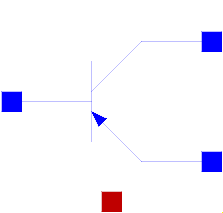 Model Modelica.Electrical.Analog.Semiconductors.HeatingPNP
Model Modelica.Electrical.Analog.Semiconductors.HeatingPNP
This model is a simple model of a bipolar PNP junction transistor according to Ebers-Moll.
A heating port is added for thermal electric simulation. The heating port is defined in the Modelica.Thermal library.
A typical parameter set is (the parameter Vt is no longer used):
Bf Br Is Vak Tauf Taur Ccs Cje Cjc Phie Me PHic Mc Gbc Gbe - - A V s s F F F V - V - mS mS 50 0.1 1e-16 0.02 0.12e-9 5e-9 1e-12 0.4e-12 0.5e-12 0.8 0.4 0.8 0.333 1e-15 1e-15
References:
Vlach, J.; Singal, K.: Computer methods for circuit analysis and design. Van Nostrand Reinhold, New York 1983 on page 317 ff.
Extends from Modelica.Electrical.Analog.Interfaces.ConditionalHeatPort (Partial model to include a conditional HeatPort in order to describe the power loss via a thermal network).
| Type | Name | Default | Description |
|---|---|---|---|
Real | Bf | 50 | Forward beta |
Real | Br | 0.1 | Reverse beta |
Current | Is | 1e-16 | Transport saturation current |
InversePotential | Vak | 0.02 | Early voltage (inverse), 1/Volt |
Time | Tauf | 1.2e-10 | Ideal forward transit time |
Time | Taur | 5e-9 | Ideal reverse transit time |
Capacitance | Ccs | 1e-12 | Collector-substrate(ground) cap. |
Capacitance | Cje | 4e-13 | Base-emitter zero bias depletion cap. |
Capacitance | Cjc | 5e-13 | Base-coll. zero bias depletion cap. |
Voltage | Phie | 0.8 | Base-emitter diffusion voltage |
Real | Me | 0.4 | Base-emitter gradation exponent |
Voltage | Phic | 0.8 | Base-collector diffusion voltage |
Real | Mc | 0.333 | Base-collector gradation exponent |
Conductance | Gbc | 1e-15 | Base-collector conductance |
Conductance | Gbe | 1e-15 | Base-emitter conductance |
Real | EMin | -100 | if x < EMin, the exp(x) function is linearized |
Real | EMax | 40 | if x > EMax, the exp(x) function is linearized |
Temperature | Tnom | 300.15 | Parameter measurement temperature |
Real | XTI | 3 | Temperature exponent for effect on Is |
Real | XTB | 0 | Forward and reverse beta temperature exponent |
Voltage | EG | 1.11 | Energy gap for temperature effect on Is |
Real | NF | 1 | Forward current emission coefficient |
Real | NR | 1 | Reverse current emission coefficient |
Boolean | useHeatPort | true | =true, if heatPort is enabled |
Temperature | T | 293.15 | Fixed device temperature if useHeatPort = false |
| Type | Name | Description |
|---|---|---|
HeatPort_a | heatPort | Conditional heat port |
Pin | C | Collector |
Pin | B | Base |
Pin | E | Emitter |
 Function Modelica.Electrical.Analog.Semiconductors.pow
Function Modelica.Electrical.Analog.Semiconductors.pow
This icon indicates Modelica functions.
Extends from Modelica.Icons.Function (Icon for functions).
| Type | Name | Description |
|---|---|---|
Real | x | |
Real | y |
| Type | Name | Description |
|---|---|---|
Real | z |
 Function Modelica.Electrical.Analog.Semiconductors.powlin
Function Modelica.Electrical.Analog.Semiconductors.powlin
This icon indicates Modelica functions.
Extends from Modelica.Icons.Function (Icon for functions).
| Type | Name | Description |
|---|---|---|
Real | x | |
Real | y |
| Type | Name | Description |
|---|---|---|
Real | z |
 Function Modelica.Electrical.Analog.Semiconductors.exlin
Function Modelica.Electrical.Analog.Semiconductors.exlin
This icon indicates Modelica functions.
Extends from Modelica.Icons.Function (Icon for functions).
| Type | Name | Description |
|---|---|---|
Real | x | |
Real | Maxexp |
| Type | Name | Description |
|---|---|---|
Real | z |
 Function Modelica.Electrical.Analog.Semiconductors.exlin2
Function Modelica.Electrical.Analog.Semiconductors.exlin2
This icon indicates Modelica functions.
Extends from Modelica.Icons.Function (Icon for functions).
| Type | Name | Description |
|---|---|---|
Real | x | |
Real | Minexp | |
Real | Maxexp |
| Type | Name | Description |
|---|---|---|
Real | z |
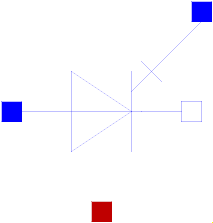 Model Modelica.Electrical.Analog.Semiconductors.Thyristor
Model Modelica.Electrical.Analog.Semiconductors.Thyristor
This is a simple thyristor model with three pins: Anode, Cathode and Gate. There are three operating modes:conducting, blocking and reverse breakthrough.
As long as the thyristor is in blocking mode it behaves like a linear resistance Roff=VDRM^2/(VTM*IH). But if the voltage between anode and cathode exceeds VDRM or a positive gate current flows for a sufficient time the mode changes to conducting mode. The model stays in conducting mode until the anode current falls below the holding current IH. There is no way to switch off the thyristor via the gate. If the voltage between anode and cathode is negative, the model represents a diode (parameters Vt, Nbv) with reverse breakthrough voltage VRRM.
The dV/dt switch on is not taken into account in this model. The gate circuit is not influenced by the main circuit.
Extends from Modelica.Electrical.Analog.Interfaces.ConditionalHeatPort (Partial model to include a conditional HeatPort in order to describe the power loss via a thermal network).
| Type | Name | Default | Description |
|---|---|---|---|
Voltage | VDRM | 100 | Forward breakthrough voltage |
Voltage | VRRM | 100 | Reverse breakthrough voltage |
Current | IDRM | 0.1 | Saturation current |
Voltage | VTM | 1.7 | Conducting voltage |
Current | IH | 0.006 | Holding current |
Current | ITM | 25 | Conducting current |
Voltage | VGT | 0.7 | Gate trigger voltage |
Current | IGT | 0.005 | Gate trigger current |
Time | TON | 1e-6 | Switch on time |
Time | TOFF | 1.5e-5 | Switch off time |
Voltage | Vt | 0.04 | Voltage equivalent of temperature (kT/qn) |
Real | Nbv | 0.74 | Reverse Breakthrough emission coefficient |
Boolean | useHeatPort | false | =true, if heatPort is enabled |
Temperature | T | 293.15 | Fixed device temperature if useHeatPort = false |
| Type | Name | Description |
|---|---|---|
HeatPort_a | heatPort | Conditional heat port |
PositivePin | Anode | |
NegativePin | Cathode | |
PositivePin | Gate |
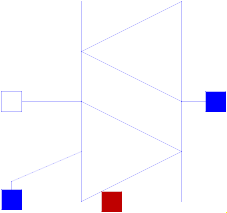 Model Modelica.Electrical.Analog.Semiconductors.SimpleTriac
Model Modelica.Electrical.Analog.Semiconductors.SimpleTriac
This is a simple TRIAC model based on the extended thyristor model Modelica.Electrical.Analog.Semiconductors.Thyristor.
Two thyristors are contrarily connected in parallel, whereas each transistor is connected with a diode.
Further information regarding the electrical component TRIAC can be detected in documentation of the ideal TRIAC model.
As an additional information: this model is based on the Modelica.Electrical.Analog.Semiconductors.Thyristor.
Attention: The model seems to be very sensitive with respect to the choice of some parameters (e.g., VDRM, VRRM). This is caused by the thyristor model. Further investigations are necessary.
| Type | Name | Default | Description |
|---|---|---|---|
Voltage | VDRM | 100 | Forward breakthrough voltage |
Voltage | VRRM | 100 | Reverse breakthrough voltage |
Current | IDRM | 0.1 | Saturation current |
Voltage | VTM | 1.7 | Conducting voltage |
Current | IH | 0.006 | Holding current |
Current | ITM | 25 | Conducting current |
Voltage | VGT | 0.7 | Gate trigger voltage |
Current | IGT | 0.005 | Gate trigger current |
Time | TON | 1e-6 | Switch on time |
Time | TOFF | 1.5e-5 | Switch off time |
Voltage | Vt | 0.04 | Voltage equivalent of temperature (kT/qn) |
Real | Nbv | 0.74 | Reverse Breakthrough emission coefficient |
Boolean | useHeatPort | false | =true, if HeatPort is enabled |
Temperature | T | 293.15 | Fixed device temperature if useHeatPort = false |
| Type | Name | Description |
|---|---|---|
NegativePin | n | Cathode |
PositivePin | p | Anode |
PositivePin | g | Gate |
HeatPort_a | heatPort |